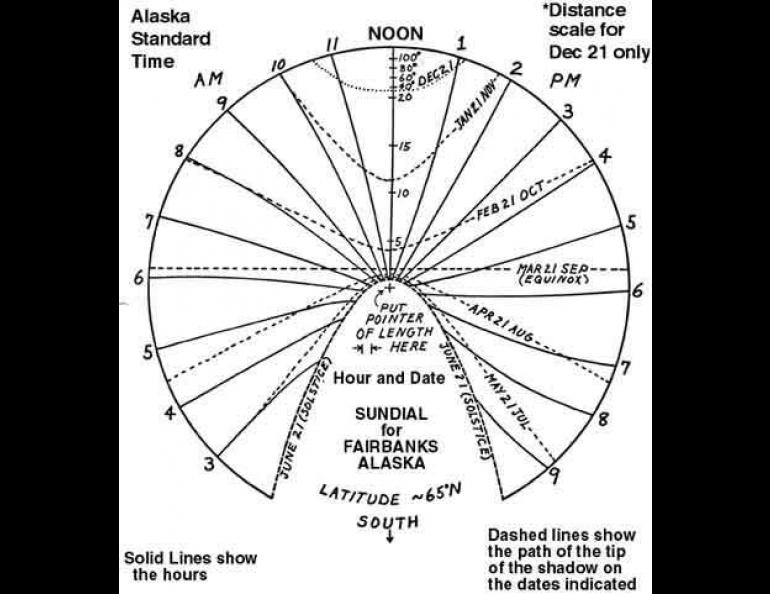
A Sundial for Fairbanks
Sundials were on their way out a thousand years ago when fledgling inventions led to the development of modern clocks. In those early times the hour had no fixed length; it depended upon season and latitude.
Simplest of all sundials is one with a vertical pointer (a gnomon) which casts its shadow on a flat surface marked to show the passage of the hours. We show here such a sundial designed specifically for Fairbanks. In one sense it is a rather fancy sundial because it tells both the hour of the day and the day of the year. This ability comes from the use of the University's high-speed computer, which gives us a leg up on the old-time sundial designers. The design is based upon calculations by Professor Hans Nielsen showing the length of a vertical stick's shadow each hour of the day and the direction to the shadow tip.
Dashed lines show the paths of the end of the pointer's shadow across the sundial on the days indicated. We drew in only the twenty-first day of each month to illustrate the extreme positions occurring on the solstices (June 21 and December 21) and at equinox (March 21 and September 21).
Moving along the line marked June 21, one sees that the Fairbanks sundial works from before 3 a.m. until after 9 p.m. But on the shortest day of the year, December 21, it only works from about ll a.m. until l p.m., the time when the sun is above the horizon.
Notice that the sundial is 25 pointer lengths in radius. On December 21 the shadow doesn't even fall on the sundial; we indicate that by using a dotted line and the special distance scale marked by asterisks.
The radial hour lines of the sundial are curved to account for the changes in the sun's apparent motion across the sky with season. If the lines were not curved, the sundial "clock" would run faster than a normal clock at some times of the year and at other times, slower.
This sundial illustrates that Alaska truly is the land of long shadows, with remarkable variations through the course of the year. One curiosity--notice that the shadow of the tip of an object marches across the ground in a perfectly straight line on two days of the year, the equinox days.
Though called a sundial for Fairbanks, this one will work reasonably well any location of similar latitude, locations such as Dawson, Eagle, Tanana, Nulato and Nome.





